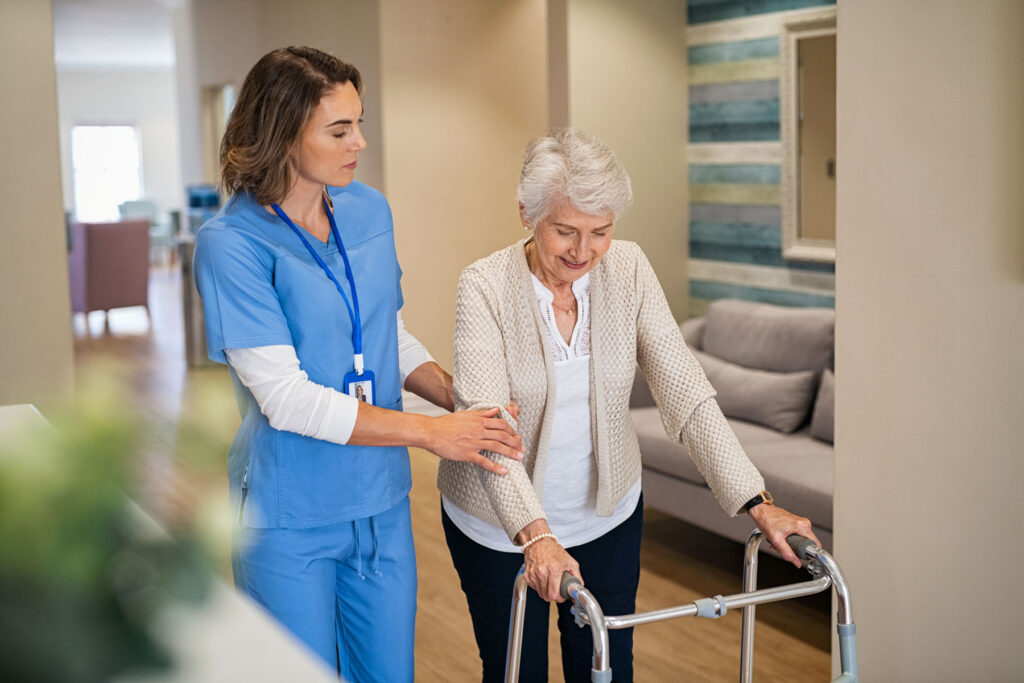Your parent had a fall. What happens next can feel overwhelming.
Life changes after a fall. One day, your vibrant, independent mom is going about her daily routine. The next, she’s tripping over a curled rug corner, slipping on a wet tile, or stumbling on a slightly uneven sidewalk.
Suddenly, she’s one of the 25% of seniors who experience a fall each year. And you’re one of the adult children getting that call you’ll never forget: “Mom had a fall.”
It’s scary—especially knowing that once someone falls, their risk of falling again increases significantly. But the good news is, many falls can be prevented. In fact, one of the most effective ways to reduce fall risk is moving to an assisted living community where safety, mobility, and wellness are built into daily life.
Here’s how assisted living supports fall prevention and a healthier future.
A culture of safety
Many falls happen due to hazards around the home: poor lighting, loose rugs, clutter, slippery floors, or improper use of canes or walkers. In assisted living communities, these risks are addressed from day one.
Communities are designed with safety in mind, featuring:
- Barrier-free bathrooms and walkways
- Handrails and grab bars throughout the building
- Non-slip flooring
- Accessible layouts and lighting
- 24/7 staffing and regular wellness checks
Residents also receive fall risk evaluations upon move-in. These assessments help staff understand medical history, balance issues, use of assistive devices, and personal habits—allowing them to create safer, more personalized environments.
Support with daily tasks
Everyday tasks like bathing, dressing, or carrying laundry can become dangerous without support. If your parent is navigating stairs, lifting heavy items, or skipping their walker to “save time,” the risk of falling increases.
In assisted living, caregivers are available to assist with:
- Bathing, dressing, and grooming
- Mobility and transfers
- Toileting and hygiene
- Meal support and medication reminders
This allows residents to remain independent while reducing their risk of injury during routine activities.
Strength through movement
It’s common for older adults to become less active over time. But inactivity leads to reduced strength, coordination, and balance—all of which increase the likelihood of falling.
Assisted living communities promote movement through daily wellness programming. Residents can join classes such as:
- Chair yoga and seated stretching
- Tai chi and balance training
- Resistance band workouts and light strength training
- Group walks and gentle mobility sessions
Some programs even teach fall recovery techniques to help residents regain confidence and reduce injury should a fall occur.
Medication management
Certain medications can increase dizziness, drowsiness, or blood pressure fluctuations—all of which raise fall risk. At home, medication schedules can be hard to manage, especially when multiple prescriptions are involved.
In assisted living, professional care teams:
- Monitor medications and side effects
- Administer doses safely and consistently
- Coordinate refills and doctor communication
With careful medication oversight, residents are more alert, stable, and secure.
Nutrition that supports balance and strength
A healthy, balanced diet is often overlooked in fall prevention—but it’s a key piece of the puzzle. Seniors who are dehydrated or missing key nutrients like calcium or vitamin D are more prone to weakness and fatigue.
Assisted living communities offer:
- Daily meals with bone- and muscle-supporting nutrients
- Snack options and hydration stations
- Personalized support for dietary needs
With better nutrition, residents gain strength and stamina—and feel more energized for daily life.
Why fall prevention is about more than safety
Falls rarely happen because of just one thing. They often result from a combination of environment, health, and habits. That’s why assisted living offers such a powerful solution—it addresses the full picture.
While no environment can eliminate fall risk entirely, assisted living communities are equipped to prevent, reduce, and respond to falls more effectively than most home settings. From mobility support and medication monitoring to thoughtful design and wellness programs, everything is built with resident safety in mind.
How our communities help your loved one feel confident and secure
At The Arbors and The Ivy, we understand how stressful it can be to worry about your parent’s safety. That’s why we’ve created warm, welcoming communities where fall prevention isn’t an afterthought—it’s part of our daily care.
If your loved one has experienced a fall—or if you’re concerned they’re at risk—we’re here to help you take the next step.
Learn more about our assisted living communities and how we support safety, mobility, and peace of mind. Contact us today for more information or to schedule a tour.

